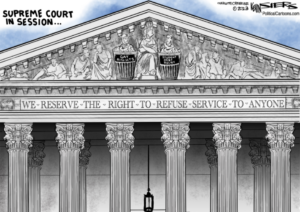CHURCH & STATE | The Supreme Court Has Blessed Religion-Based Discrimination. What’s Next?
 Unequal Justice before the law by Kevin Siers, The Charlotte Observer, NC
Unequal Justice before the law by Kevin Siers, The Charlotte Observer, NC The U.S. Supreme Court’s June 30 ruling in 303 Creative LLC v. Elenis allowing a Colorado website designer to refuse to provide services to LGBTQ+ clients because of her religious beliefs is problematic on many levels and leaves a host of unanswered questions.
The case was brought by Alliance Defending Freedom, a large, well-heeled Christian Nationalist legal group, on behalf of Lorie Smith, owner of 303 Creative LLC. The case revolved around an entirely theoretical question concerning wedding websites for same-sex couples. Smith’s firm doesn’t actually design wedding websites, and no same-sex couple had asked her to make one. But she argued that she might want to someday offer this service, and if she does, she doesn’t want to serve LGBTQ+ clients.
That’s a problem because Colorado law prohibits discrimination against several protected classes, including LGBTQ+ residents. Smith lost in two lower federal courts, but the Supreme Court reversed those decisions, asserting that requiring Smith to refrain from discriminating would be a form of compelled speech.
The Supreme Court ignored the point that Smith, by creating websites, would merely have been making a vehicle for the speech of others, not actually speaking herself. A six-justice majority declared that her conduct as a designer is “expressive” and thus protected by the First Amendment’s Free Speech Clause.
The word “expressive” is slippery, and therein lies the problem. Justice Neil M. Gorsuch, who wrote the majority opinion, admitted as much, writing, “determining what qualifies as expressive activity protected by the First Amendment can sometimes raise difficult questions.”
We’re already seeing them. A few weeks after the ruling was handed down, a hair stylist in Traverse City, Michigan, announced that she won’t serve transgender clients. Christine Geiger told trans people to go to “a local pet groomer. You are not welcome at this salon. Period.”
Will courts permit Geiger to do this? We have no idea. It may depend on whether cutting, styling, or coloring someone’s hair counts as “expressive” conduct. The Michigan Attorney General’s Office says it’s not, but would the U.S. Supreme Court agree? Only more litigation will determine that.
One thing we do know is that thanks to this ruling, LGBTQ+ people and anyone else who offends a fundamentalist may find themselves cut off from everyday forms of commerce.
Can a restaurant refuse service to a same-sex couple? It may depend on whether preparing food is expressive conduct. A diner where everything gets tossed into a deep fryer or slapped on a grill might have a hard time arguing that this sort of food preparation is expressive. But what about a five-star restaurant owned by an exacting chef who argues that each meal is individually tailored to the customer? Is that expressive enough?
Hotels, motels, and other places that rent rooms used to refuse service to blacks, Jews, and others, especially in the South. The civil rights laws of the 1960s put a stop to that appalling practice–or so we thought. Thanks to the 303 Creative ruling, blatant forms of discrimination in many businesses that are considered public accommodations might see a comeback.
Let’s say Larry owns a 100-room hotel where every unit looks the same. There’s not much expressive content there, so Larry might have a hard time turning away LGBTQ+ people. But what if Larry owns a four-room B&B and claims that, before each rental, he painstakingly prepares each room to fit the characteristics of each customer? Does Larry’s interior decorating count as expressive conduct? Does he now have the right to refuse rooms to LGBTQ+ guests or anyone else whose mere existence offends his religious beliefs? Again, only more litigation will tell.
Underlying all this is a burning question that the court simply didn’t answer: What exactly is expressive activity? And around this revolves another unanswered, but equally important, question: Does expressive activity have to be creative to win First Amendment protection?
If you look up “expressive” in a dictionary, you’ll find something like this: “effectively conveying thought or feeling.” That’s pretty broad. Taken literally, it would encompass any number of mundane activities.
After marriage equality became the law of the land in 2015, government workers in some parts of the country refused to issue licenses and other forms of paperwork to same-sex couples. Is merely filling out forms and stamping papers expressive? After all, it does convey a thought.
Some of these examples may seem ridiculous, but we’re currently living under the shadow of an extreme Supreme Court that seems willing to buy into any argument, no matter how bizarre, if the six-justice ultraconservative bloc finds it helpful in rolling back progress. Don’t assume any argument is too absurd to win traction before this court.
Remember, reality and facts are increasingly meaningless to this court. In a case from last term, the far-right bloc ruled in favor of a public high school football coach in Washington state who argued that his prayers at the 50-yard line after games when he was surrounded by student-athletes were “private” when anyone could clearly see that they were not. A lower court asserted that the entire case rested on a “deceitful narrative.” That meant nothing to the extreme bloc on the Supreme Court, which was eager to further erode church-state separation.
We have entered a dangerous period. The highest court in the land is gaslighting the entire nation. It is remaking American culture along Christian Nationalist lines, blithely obliterating decades of rights with the stroke of a pen.
Don’t assume we’re through the worst of it. This reactionary court is determined to foist a vision of America onto us that most people don’t want, a vision that simply doesn’t work for the country we are.
Even more tragically, they may just be getting started.
